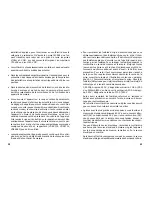
19
Possibility 2:
D1) Carry out steps D1) and D2) in "Possibility 1". Then touch with
the test probes the point to be measured, the value of which
is to be set as the upper limit (Hi).
Press the button "
REL" until the desired value is displayed
in the main display. At the same time the rightmost digit
remains flashing. Now remove the test probes from the points
of measurement. Press the "COMP" button four times, until
"Hi" disappears from the small display and instead "Lo"
appears.
D2) Connect the test probes to another point to be measured ,
which is to be set as the lower limit (Lo). Now press the " R-
H" until the desired value appears in the main display. Here,
too, the rightmost digit remains flashing. Remove the test
probes from the (second) point to be measured. Press the
"COMP" button four times, until "Lo" disappears from the
small display and the comparison measurement begins. In the
absence of an applied measurement signal, "Lo" is displayed,
with in addition "0000" in the small display. Under resistance,
diode test and continuity check measurements "Hi" appears
in the main instead of "Lo". In the small display "OL" (Over
load) appears instead of "0000".
D3) Connect the test probes to the measurement point, the value
of which is to be set as the comparison measurement value. If
the present measured value shown in the small display is
lower than the set lower comparison value, then "Lo"
appears in the main display. If the present measured value lies
above the set upper comparison value, "Hi" appears in the
main display. If the present measured value lies between the
set upper and lower comparison values, "Pass" appears in the
main display.
D4) To be able to leave the function, the measuring instrument
must first be removed from the measurement circuit and the
rotary switch then moved to another switch position.
18
D4) The next-left digit flashes. Proceed as described in c) until the
whole "Hi" comparison value is set.
D5) Press the yellow button once "COMP". The upper limit value
"Hi" is stored in memory, "Hi" disappears from the small dis-
play and "Lo" (Low = lower comparison or limit value)
appears in its place. Once again the rightmost digit flashes.
D6) Carry out the setting of the lower limit values as described in
c. Then, press the "COMP" button once again. The comparison
measurement begins. In the absence of an applied measure-
ment signal, "Lo" is displayed, with in addition "0000" in the
small display.
Under resistance measurement, diode test and continuity
check, "Hi" appears in the main display instead of "Lo". In the
small display "OL" (Overload) appears instead of "0000".
D7) Connect the test probes to the measurement point, the value
of which is to be set as the comparison measurement value. If
the present measured value displayed in the small display is
lower than the lower comparison value set, then "Lo"
appears in the main display. If the present measured value lies
above the set upper comparison value, "Hi" appears in the
main display. If the present measured value lies between the
upper and lower comparison values set, "Pass" appears in the
main display.
D8) To be able to leave the function, the measuring instrument
must first be removed from the measurement circuit and the
rotary switch then moved to another switch position.
Note
Negative measured values cannot be set.

























